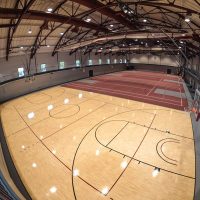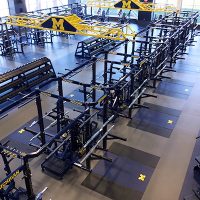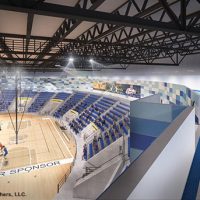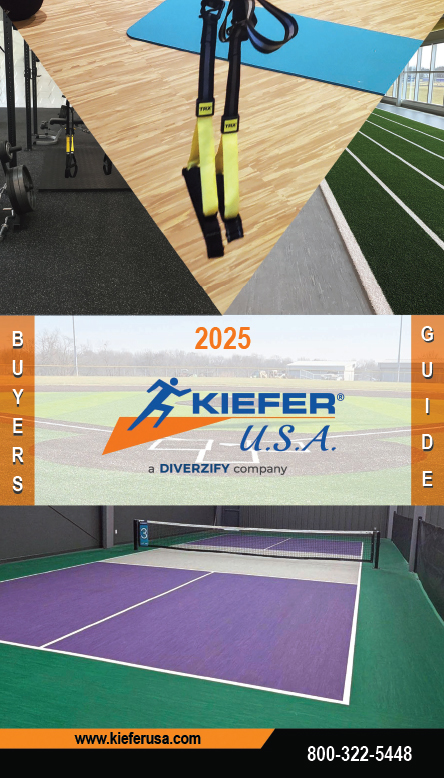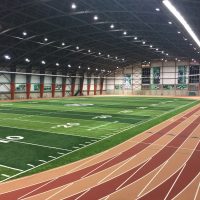
Indoor Sports Flooring – Turf Buying Guide
With turf fields becoming less expensive, higher-quality, and more user-friendly by the day, it’s no wonder that more and more sports facilities around the world are opting for turf flooring. Sports turf is extremely versatile, very durable, high-performing, visually appealing, and easy to maintain. What’s more, synthetic grass maximizes the productive use of a field, as it can be used day-in and day-out without excessive wear and regardless of the weather conditions.
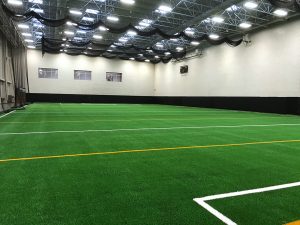 The fantastic look and feel of artificial grass and the numerous advantages of turf flooring have made artificial turf a trendy flooring option for gyms, fitness studios, health clubs, and field houses across the country.
The fantastic look and feel of artificial grass and the numerous advantages of turf flooring have made artificial turf a trendy flooring option for gyms, fitness studios, health clubs, and field houses across the country.
If you too are considering synthetic turf for your sports facility, it is important to know as much as possible about different turf products and their characteristics so you can choose the right flooring for your needs. To get the most value out of your investment, you must define your needs, explore the available options, and make an informed decision.
The turf buying guide below will provide you with all the information you need to make the best choice for your sports flooring project.
Why Choose Artificial Turf for Your Sports Facility
Gym turf is a safe, high-performing, and long-lasting sports flooring option that allows athletes to train in exciting and challenging ways.
The greatest benefits of artificial turf include:
1) Versatility – Synthetic turf is suitable for a wide variety of sports activities:
- Artificial grass is ideal for pulling or pushing sleds, completing CrossFit WODs, and performing HIIT workouts;
- Gym turf flooring is sound absorbing which makes it perfect for weight lifting and high-intensity work – the artificial grass minimizes the clinking-and-clanking in the gym and the durability of the turf system allows it to withstand heavy use, so weights won’t ruin the floor;
- Resilient and shock-absorbent, turf surfaces are great for speed and agility training because they’re easy on the joints and muscles;
- The flat, cushioned surface is very convenient for body-weight workouts and stretching.
Furthermore, turf flooring in the field house can keep sports going all year round in the community with indoor soccer, football, lacrosse, baseball, and more.
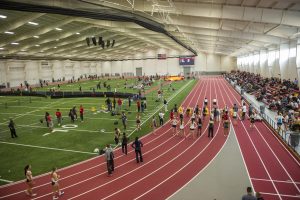 2) Safety – Sports turf is non-abrasive and provides the traction athletes need to make quick movements without injuring themselves. Most artificial turf systems come with foam padding that cushions falls and provides an extra layer of protection between the athletes and the concrete. Moreover, the granules of recycled rubber spread between the artificial grass blades give the surface a good bounce and make it soft to fall on.
2) Safety – Sports turf is non-abrasive and provides the traction athletes need to make quick movements without injuring themselves. Most artificial turf systems come with foam padding that cushions falls and provides an extra layer of protection between the athletes and the concrete. Moreover, the granules of recycled rubber spread between the artificial grass blades give the surface a good bounce and make it soft to fall on.
3) Durability – Gym turf can withstand heavy use and plenty of wear and tear without losing its fantastic look and great performance qualities.
4) Ease of maintenance – Turf surfaces are easy to clean and require little upkeep which saves gym owners plenty of time and money.
5) Aesthetic appeal – Green and fresh at all times, synthetic grass is very pleasing to the eye and the turf’s edgy design looks awesome. Gym owners can choose from a variety of styles and colors to give their facility a modern, unique appearance. Adding your logo can be a great way to show off your brand.
With so many good reasons to buy artificial turf for your sports facility, there is little to hesitate about. It’s time to see what the market has to offer.
Gym Turf Options
When shopping for synthetic turf products, you need to research your options well and understand the specifics of different synthetic turf products, infill materials, types of backings, etc.
Turf Flooring Products
There are two types of turf flooring options for sports facilities:
- Turf rolls – Durable and resilient, turf rolls are perfect for weightlifting and high-intensity workouts, running and body-weight exercises;
- Turf tiles – Interlocking turf tiles are ideal for covering oddly shaped areas (they can be cut to fit any space) and can withstand plenty of abuse without showing any wear and tear.
The best turf flooring product for your gym, fitness studio, health club, or field house depends on the layout of the facility and the type of activities that will take place in the sports complex.
Face Weight
Face weight designates the amount of material used in a turf flooring product per square yard. The greater the face weight, the more durable the turf, so be sure to choose a product with a higher face weight for high-traffic areas, weight rooms, and other sections of the gym intended for high-impact exercises.
Yarn Types, Fiber Shapes, and Pile Height
There are three types of synthetic grass yarns used for turf flooring:
- Polypropylene (PP) is cheaper than other types of yarn and wears out much easier, so it is only suitable for low-traffic areas;
- Polyethylene (PE) is very soft and looks like real grass. It is widely used on soccer fields and tennis courts;
- Nylon is the strongest artificial turf yarn available – it can withstand high temperatures, great weight, and heavy impact and still retain its original shape. This type of artificial turf is most commonly used for high end putting greens, running tracks, and weight rooms.
In addition to the type of yarn, the shape of the grass fibers should also be taken into account when choosing gym turf flooring – thinner tape fibers typically wear much faster than high performance 3D fibers.
Pile height (the height of the yarn that rises above the turf backing) is another important factor that determines the functionality and durability of turf flooring. Long pile turf looks and feels like natural grass, while low pile allows athletes to push a sled across without destroying the floor.
Mondo Artificial Turf Systems:
Backings
All turf flooring products have primary and secondary backing.
The primary backing is the first layer of material used to tuft yarn. A good backing cloth is easily tufted, resists fraying, absorbs coatings, and has high dimensional stability.
When it comes to the secondary backing of your sports turf flooring system (a coating applied to the primary backing to help hold the tufts in place), you can choose from:
- Urethane backing – The most common type of backing in the industry. It has great tuft lock strength (the force needed to pull out yarn fibers) and can be perforated with holes to allow water to drain through when designed for outdoor use;
- Geo-textile cloth – The non-woven Geo-textile secondary backing is produced in such a way that the grass fibers are arranged randomly, giving them isotropic properties for strength and elongation that add greater dimensional stability to the flooring system. This type of turf has a good tuft lock strength and water permeability of about 100 inches/hour;
- Cushion backing – Attached foam cushions make the turf flooring softer underfoot and safer for athletes. The cushions can be perforated similarly to the way urethane backings are to allow for proper drainage when needed.
Infill
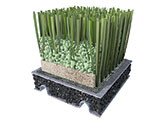 In-fill materials (most often granulated rubber and rounded sand) are spread on top of the turf surface to fill out the space between the grass blades. The granules add durability to the surface, support the fibers, and contribute to the performance characteristics of the turf flooring system.
In-fill materials (most often granulated rubber and rounded sand) are spread on top of the turf surface to fill out the space between the grass blades. The granules add durability to the surface, support the fibers, and contribute to the performance characteristics of the turf flooring system.
Rubber provides resiliency to the turf field, while sand adds the feeling of natural firmness underfoot and helps weigh the turf down. Rubber-to-sand ratios may range widely depending on the desired playability characteristics of the turf field (generally speaking, the more sand, the firmer and faster the surface).
When considering buying artificial turf, in addition to the available turf flooring options you need to be aware of the installation and maintenance requirements of the flooring system as well.
Non-Infill Indoor Turf – strength training turf | weight room turf
Mondoturf – Ecofill Turf Infill System
Synthetic Turf Installation
Sports turf installation isn’t overly difficult, but it’s always better to leave the job to the professionals when it comes to large, high-traffic areas such as commercial gyms, fitness studios, or field houses. The experts will ensure a solid foundation, proper synthetic grass installation, secure seaming, and quality infilling:
- Base construction/preparation
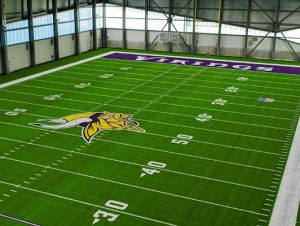 The base provides a stable platform and effective drainage system for the turf field. It has to be well-engineered and well-constructed to ensure the high performance and durability of the turf flooring.
The base provides a stable platform and effective drainage system for the turf field. It has to be well-engineered and well-constructed to ensure the high performance and durability of the turf flooring.
For outdoor turf systems, all existing grass and weeds from the designated installation area need to be removed from the site (including the root zones), the soil has to be tightly compacted and properly graded, and an aggregate foundation that may or may not be topped by an asphalt pavement must be constructed.
For indoor turf systems, the sub-floor must be completely level, clean, and dry before installation begins.
An elastic layer (the so-called shockpad) consisting of rubber mats, felt pads, or rubber granules can be placed between the base and the turf for extra cushioning and increased safety and comfort.
- Synthetic grass installation
- Turf rolls are laid on the surface and glued down with an adhesive or double-sided tape. The grain of the fibers on every roll of turf should run in the same direction. If deemed necessary, the edges of the rolls can be secured to the ground with galvanized nails.
Then, the rolls are seamed together. Seams may be secured with strong adhesives or by sewing – what matters is to make them neat and durable, as seams tend to be the weakest point of a turf field. A lot of skill and attention is required at this step of the installation process to ensure the endurance and seamless appearance of the turf flooring.
Finally, the turf flooring is rolled with a 75 lb. weighted roller across the width and length of the surface.
- Interlocking turf tiles are snapped together like puzzle pieces. Double-sided mat tape can be used to keep them secure.
When installing turf tiles, it is recommended to leave a gap along the walls of the room (as big as the thickness of the tiles being used) to account for expansion and contraction of the floor due to temperature fluctuations.
- Infilling
The final step of the turf installation process is the spreading of the in-fill materials. For better performance and higher durability, 1.5 – 2 pounds of infill are recommended per square foot.
A power broom is used to fluff up the turf fibers and work in the infill material evenly in-between the blades of grass.
Artificial Turf Maintenance
Proper upkeep will enhance performance and extend the useful life of your turf flooring system. Recommended maintenance practices include regular brushing to redistribute infill and lift pile and daily vacuuming to remove debris. Stains on the grass can be cleaned with a solution of mild detergent and warm water or a mixture of white distilled vinegar in an equal amount of water.
With so many options available, you need to give a lot of thought to choosing the best turf flooring system for your sports facility. You must consider the initial synthetic turf cost and the expected maintenance costs, the life-expectancy and wear of the turf flooring system, the performance characteristics of the athletic flooring, etc.
Contact Kiefer USA
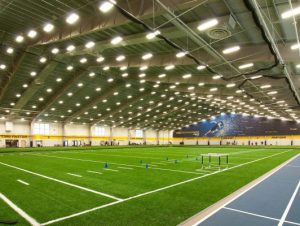 The professionals at Kiefer USA can help you make the right choice by providing you with all the information you need and will discuss the details of your synthetic turf design and installation with you. Working with Kiefer USA will ensure that you get the best sports surface for your needs at the most reasonable price.
The professionals at Kiefer USA can help you make the right choice by providing you with all the information you need and will discuss the details of your synthetic turf design and installation with you. Working with Kiefer USA will ensure that you get the best sports surface for your needs at the most reasonable price.
KieferUSA’s artificial indoor turf products are superior in performance and longevity to any other on the market. In addition to that, we offer highly competitive prices and outstanding customer service.
So, if you intend to buy turf, be sure to call us at (800) 322-5448 to consult with our experts, receive tailored professional advice, get the best indoor artificial turf products available, and have your turf flooring installed in a safe, competent, and efficient manner.
